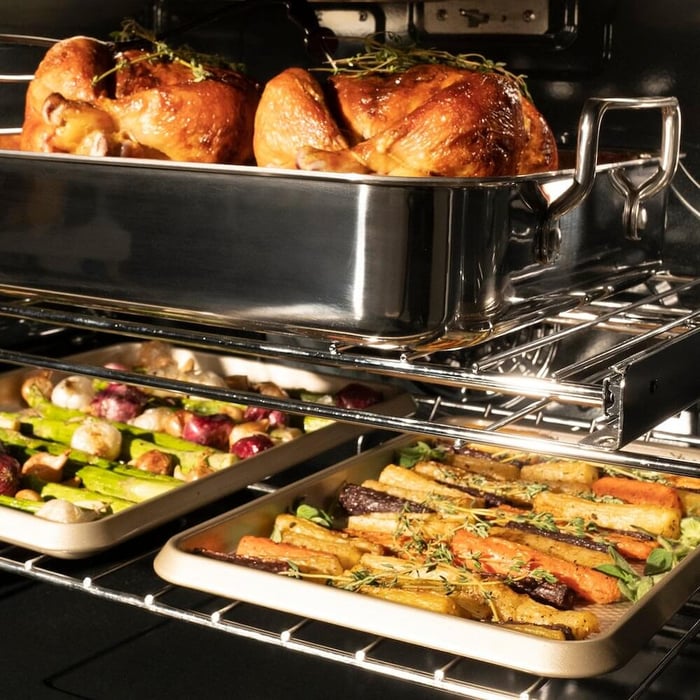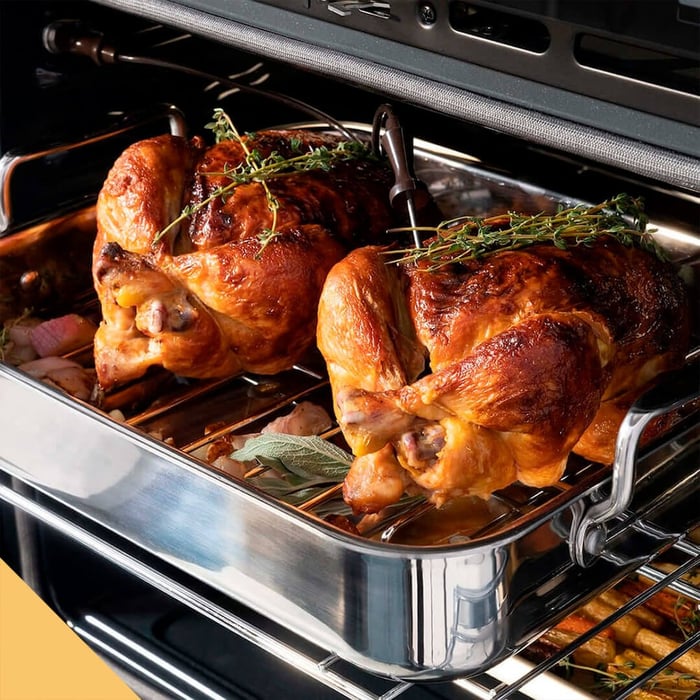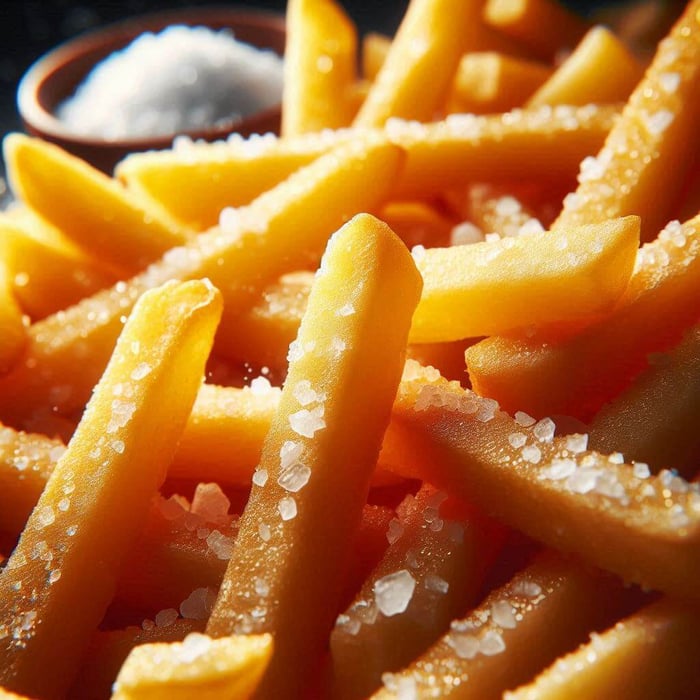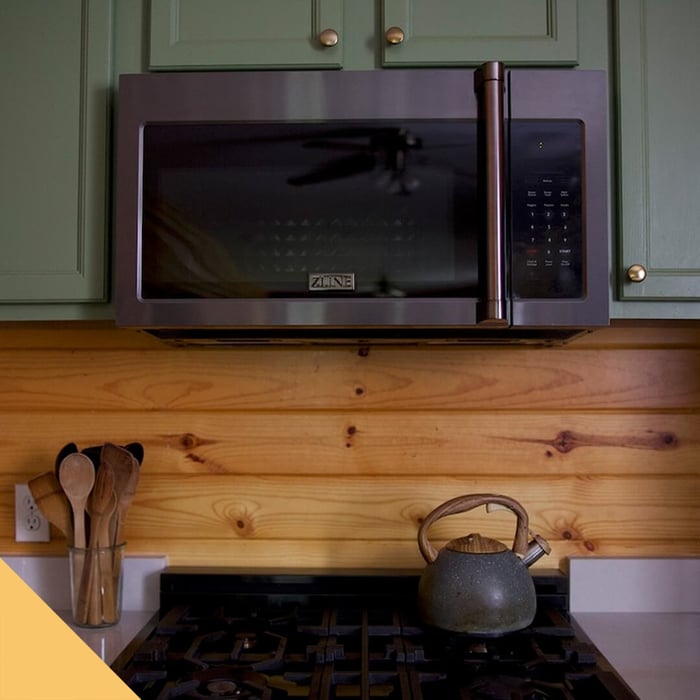Table of Contents
Air frying and convection cooking have both revolutionized the way we prepare meals, so it comes as no surprise that ZLINE Kitchen and Bath included both modes on their newest electric wall ovens. With both modes available, you may be wondering when you should use air fry and when you should use convection. In this blog, we detail Air Fry vs. Convection.
Both cooking methods provide faster cooking times and healthier alternatives to traditional frying or baking. However, subtle differences in the way hot air is circulated exist between the two modes, and understanding when to use each technique will bring your recipes to another level.
This blog answers the question: “What’s the difference between air frying and convection cooking?” Knowing this difference will help you make the best choice for your next dish.
Understanding Air Frying
What is Air Frying?
Air frying is a cooking method that uses hot air circulation to cook food quickly, giving it a crispy texture similar to deep frying but without the excessive use of oil. By using a fan to circulate heat, air frying cooks food evenly on all sides, mimicking the results of traditional frying methods in a healthier way.
Benefits of Air Frying
Healthier Cooking with Less Oil: Air frying requires just a small amount of oil, making your meals lower in fat while achieving that coveted crunchy exterior.
Faster Cooking Times: Foods like French fries or chicken wings cook much faster than traditional ovens.
Crispy Texture: The rapid hot air circulation creates a golden, crispy texture, similar to what you’d get from a deep fryer.
ZLINE Autograph Edition 30 in. Professional True Convection Double Wall Oven with Air Fry and Self Clean in Black Stainless Steel with Polished Gold Handles (WADBZ-30-G)

$3,599.99
$3,999.99
Luxury isn’t meant to be desired - it’s meant to be attainable. The ZLINE 30 in. Autograph Edition Professional True Convection Double Wall Oven with Air Fry and Self Clean in Black Stainless Steel with Polished Gold Handles (WADBZ-30-G) provides… Read More
Best Uses for Air Frying
Ideal for foods that benefit from a crispy texture, such as:
- Fries: Achieve golden, crunchy French fries without deep frying.
- Chicken Wings: Get crispy, juicy wings without all the extra oil.
- Vegetables: Brings out the best in veggies like zucchini, Brussels sprouts, and sweet potatoes.
Tips for the Best Results:
- Preheat for even cooking.
- Avoid overcrowding to ensure proper air circulation.
- Lightly coat food with oil to enhance crispiness.
Understanding Convection Cooking
What is Convection Cooking?
Convection cooking uses a fan to circulate hot air within an oven, allowing food to cook more evenly and efficiently than in traditional ovens. This method speeds up cooking times and ensures an even heat distribution, making it perfect for baking and roasting.
Benefits of Convection Cooking
Even Cooking and Browning: The circulating air ensures that your food is browned evenly, whether you’re roasting a chicken or baking a batch of cookies.
Faster Cooking Times: Convection ovens typically cook food faster than conventional ovens, making them ideal for busy weeknight meals.
Versatility: From savory roasts to sweet pastries, convection cooking is highly versatile and suitable for a wide range of dishes.
ZLINE 30 in. Professional True Convection Single Wall Oven with Air Fry and Self Clean in Stainless Steel (WAS-30)

$2,159.99
$2,399.99
Luxury isn’t meant to be desired - it’s meant to be attainable. The ZLINE 30 in. Professional True Convection Single Wall Oven with Air Fry and Self Clean in Stainless Steel (WAS-30) provides a professional culinary experience by pairing reliable,… Read More
Best Uses for Convection Cooking
Convection shines in cooking dishes that benefit from even heat distribution:
- Roasts: Whether it’s a juicy chicken or tender beef, convection helps achieve the perfect roast.
- Baked Goods: Cookies, pies, and cakes bake more evenly, resulting in a beautiful, golden crust.
- Casseroles: Cooking multiple layers evenly is a breeze in a convection oven.
Tips for the Best Convection Results:
- Lower the temperature and check your food often when using convection settings to prevent overcooking.
- Avoid covering food with foil, as it can block the airflow and hinder even cooking.

ZLINE Kitchen Package with Refrigeration, 48 in. Stainless Steel Rangetop, 48 in. Range Hood and 30 in. Single Wall Oven (4KPR-RTRH48-AWS)

$8,792.96
$9,149.80
Shop the ZLINE 4-Piece Appliance Package. Completely elevate your kitchen with the ultimate ZLINE kitchen appliance package. Save more when you purchase as a package and leave more in the budget for your dream home. This Bundle Includes: ZLINE 36… Read More
When to Use Air Fry vs. Convection
Both air frying and convection can deliver similar results on many dishes, but for true perfection, you’ll want to consider the mode carefully. When choosing between the two modes, consider the type of food, the desired texture, and the cooking time:
- Type of Food: Air frying is best for small, crispy foods, while convection excels with larger dishes or baked goods.
- Desired Texture: Air frying offers a crispier result, while convection is better for even cooking and browning.
- Cooking Time and Convenience: Both methods speed up cooking times, but air fryers are great for quick snacks, while convection ovens are ideal for multi-rack cooking and roasting.
- Air Fry: Perfect for quick snacks, reheating leftovers, and achieving that irresistible crunch.
- Convection: Best for baking, roasting, or cooking multiple dishes simultaneously.
Air Fry vs. Convection: Which is Better?
Both air frying and convection cooking bring their own unique benefits to the kitchen. Mastering both methods will unlock a variety of possibilities. With ZLINE’s all-new built-in electric wall ovens with convection and air fry, you won’t need to decide between two appliances!
Recipes to Try
Air Fry Recipes
Crispy Chicken Wings
Ingredients: Chicken wings, olive oil, salt, pepper, garlic powder, paprika.
Instructions: Toss wings in oil and spices. Air fry at 400°F for 25 minutes, flipping halfway.
French Fries
Ingredients: Potatoes, olive oil, salt.
Instructions: Cut potatoes into fries, toss with oil and salt, and air fry at 375°F for 15-20 minutes.
Vegetables
Ingredients: Your choice of vegetables (e.g., Brussels sprouts, zucchini), olive oil, salt, and pepper.
Instructions: Toss veggies in oil and seasoning, air fry at 375°F for 10-12 minutes.
Convection Recipes
Convection Oven Roasted Chicken
Ingredients: Whole chicken, olive oil, herbs, salt, pepper.
Instructions: Rub chicken with oil and seasonings. Roast in a convection oven at 375°F for 60-75 minutes.
Convection Baked Cookies
Ingredients: Your favorite cookie dough.
Instructions: Drop spoonfuls of dough on a baking sheet. Bake in a convection oven at 325°F for 10-12 minutes.
Convection Roasted Vegetables
Ingredients: Mixed vegetables (e.g., carrots, potatoes, bell peppers), olive oil, herbs.
Instructions: Toss veggies in oil and seasonings. Roast at 375°F for 20-25 minutes.
FAQs
What is the difference between air fry and convection cooking?
Both air fry and convection use fans to circulate hot air, but they are optimized for different results. Air frying uses faster, more concentrated airflow to create a crispy exterior with minimal oil, while convection cooking focuses on even heat distribution for consistent cooking and browning.
Is air frying the same as convection baking?
No. While they rely on similar technology, air fry mode is specifically designed to produce crisp textures similar to deep frying. Convection baking is better suited for evenly cooking larger dishes, baked goods, and roasts.
When should I use air fry instead of convection?
Use air fry when you want a crunchy, fried-like texture without excess oil. Air fry is ideal for smaller foods like fries, chicken wings, reheating leftovers, and roasted vegetables that benefit from crisp edges.
When is convection cooking the better option?
Convection is best for baking, roasting, and cooking larger or multi-rack dishes. It excels with cookies, cakes, casseroles, whole chickens, and roasts where even heat and consistent browning matter more than crispiness.
Does air frying require oil?
Very little oil is needed for air frying. A light coating helps enhance crispness, but air frying uses significantly less oil than traditional frying methods.
Does convection cooking reduce cooking time?
Yes. Convection ovens cook faster than conventional ovens because the circulating air transfers heat more efficiently. You may need to lower the temperature slightly or check food earlier to prevent overcooking.
Can air fry replace a countertop air fryer?
In many cases, yes. Built-in ovens with true air fry modes offer similar results while allowing you to cook larger portions and avoid countertop clutter.
Is air frying healthier than convection cooking?
Air frying is generally considered healthier for foods traditionally deep fried because it uses far less oil. Convection cooking is still a healthier option than conventional baking due to shorter cooking times and even heat distribution.
What types of food work best in air fry mode?
Air fry works best for foods that benefit from crispiness, such as French fries, chicken wings, breaded foods, roasted vegetables, and reheated leftovers.
What foods should I avoid air frying?
Large roasts, delicate baked goods, and dishes that require gentle, even heat are better suited for convection. Overcrowding in air fry mode can also reduce crispness.
Do convection ovens cook evenly on multiple racks?
Yes. One of the biggest advantages of convection cooking is its ability to evenly cook food on multiple racks at the same time, making it ideal for batch baking or large meals.
Do I need to adjust recipes for air fry or convection?
Often, yes. Air fry recipes typically require higher temperatures and shorter cooking times. Convection recipes may require reducing the temperature by about 25°F compared to conventional oven settings.
Can one oven have both air fry and convection?
Yes. Modern wall ovens often include both modes. This allows you to choose the best cooking method for each dish without needing multiple appliances.
Why is having both modes in one oven beneficial?
Having both air fry and convection gives you maximum flexibility. You can quickly prepare crispy snacks or reheat leftovers with air fry, then switch to convection for baking, roasting, or multi-dish meals.
Which appliances offer both air fry and convection cooking?
ZLINE wall ovens include both air fry and convection modes, allowing home cooks to enjoy fast, healthy cooking and professional-level baking performance in one appliance.
Bottom line: should I use air fry or convection?
Use air fry for crisp, quick-cooking foods and convection for even cooking, baking, and roasting. If you frequently cook a wide variety of dishes, an oven that includes both modes gives you the best of both worlds.







